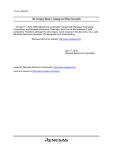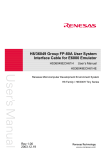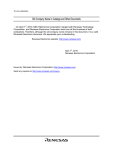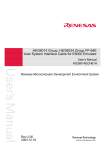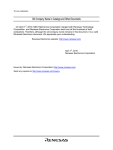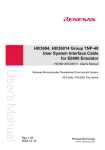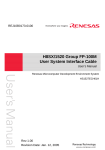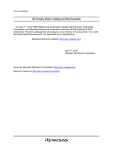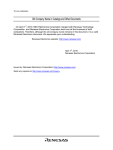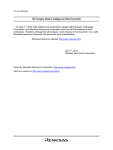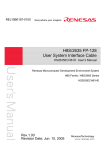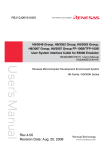Download Renesas H8/36049 User`s manual
Transcript
REJ10J1150-0300 H8/36049 Group FP-80A User System Interface Cable User’s Manual Renesas Microcomputer Development Environment System HS36049ECH61H Rev.3.00 Revision Date: Oct. 27, 2005 Keep safety first in your circuit designs! 1. Renesas Technology Corp. puts the maximum effort into making semiconductor products better and more reliable, but there is always the possibility that trouble may occur with them. Trouble with semiconductors may lead to personal injury, fire or property damage. Remember to give due consideration to safety when making your circuit designs, with appropriate measures such as (i) placement of substitutive, auxiliary circuits, (ii) use of nonflammable material or (iii) prevention against any malfunction or mishap. Notes regarding these materials 1. These materials are intended as a reference to assist our customers in the selection of the Renesas Technology Corp. product best suited to the customer's application; they do not convey any license under any intellectual property rights, or any other rights, belonging to Renesas Technology Corp. or a third party. 2. Renesas Technology Corp. assumes no responsibility for any damage, or infringement of any thirdparty's rights, originating in the use of any product data, diagrams, charts, programs, algorithms, or circuit application examples contained in these materials. 3. All information contained in these materials, including product data, diagrams, charts, programs and algorithms represents information on products at the time of publication of these materials, and are subject to change by Renesas Technology Corp. without notice due to product improvements or other reasons. It is therefore recommended that customers contact Renesas Technology Corp. or an authorized Renesas Technology Corp. product distributor for the latest product information before purchasing a product listed herein. The information described here may contain technical inaccuracies or typographical errors. Renesas Technology Corp. assumes no responsibility for any damage, liability, or other loss rising from these inaccuracies or errors. Please also pay attention to information published by Renesas Technology Corp. by various means, including the Renesas Technology Corp. Semiconductor home page (http://www.renesas.com). 4. When using any or all of the information contained in these materials, including product data, diagrams, charts, programs, and algorithms, please be sure to evaluate all information as a total system before making a final decision on the applicability of the information and products. Renesas Technology Corp. assumes no responsibility for any damage, liability or other loss resulting from the information contained herein. 5. Renesas Technology Corp. semiconductors are not designed or manufactured for use in a device or system that is used under circumstances in which human life is potentially at stake. Please contact Renesas Technology Corp. or an authorized Renesas Technology Corp. product distributor when considering the use of a product contained herein for any specific purposes, such as apparatus or systems for transportation, vehicular, medical, aerospace, nuclear, or undersea repeater use. 6. The prior written approval of Renesas Technology Corp. is necessary to reprint or reproduce in whole or in part these materials. 7. If these products or technologies are subject to the Japanese export control restrictions, they must be exported under a license from the Japanese government and cannot be imported into a country other than the approved destination. Any diversion or reexport contrary to the export control laws and regulations of Japan and/or the country of destination is prohibited. 8. Please contact Renesas Technology Corp. for further details on these materials or the products contained therein. IMPORTANT INFORMATION READ FIRST • READ this user's manual before using this emulator product. • KEEP the user's manual handy for future reference. Do not attempt to use the emulator product until you fully understand its mechanism. Emulator Product: Throughout this document, the term "emulator product" shall be defined as the following products produced only by Renesas Technology Corp. excluding all subsidiary products. • User system interface cable (HS36049ECH61H) The user system or a host computer is not included in this definition. Purpose of the Emulator Product: This emulator product is a software and hardware development tool for systems employing the Renesas microcomputer. This emulator product must only be used for the above purpose. Limited Applications: This emulator product is not authorized for use in MEDICAL, atomic energy, aeronautical or space technology applications without consent of the appropriate officer of a Renesas sales company. Such use includes, but is not limited to, use in life support systems. Buyers of this emulator product must notify the relevant Renesas sales offices before planning to use the product in such applications. Improvement Policy: Renesas Technology Corp. (including its subsidiaries, hereafter collectively referred to as Renesas) pursues a policy of continuing improvement in design, performance, and safety of the emulator product. Renesas reserves the right to change, wholly or partially, the specifications, design, user's manual, and other documentation at any time without notice. Target User of the Emulator Product: This emulator product should only be used by those who have carefully read and thoroughly understood the information and restrictions contained in the user's manual. Do not attempt to use the emulator product until you fully understand its mechanism. It is highly recommended that first-time users be instructed by users that are well versed in the operation of the emulator product. I LIMITED WARRANTY Renesas warrants its emulator products to be manufactured in accordance with published specifications and free from defects in material and/or workmanship. Renesas, at its option, will replace any emulator products returned intact to the factory, transportation charges prepaid, which Renesas, upon inspection, shall determine to be defective in material and/or workmanship. The foregoing shall constitute the sole remedy for any breach of Renesas’ warranty. See the Renesas warranty booklet for details on the warranty period. This warranty extends only to you, the original Purchaser. It is not transferable to anyone who subsequently purchases the emulator product from you. Renesas is not liable for any claim made by a third party or made by you for a third party. DISCLAIMER RENESAS MAKES NO WARRANTIES, EITHER EXPRESS OR IMPLIED, ORAL OR WRITTEN, EXCEPT AS PROVIDED HEREIN, INCLUDING WITHOUT LIMITATION THEREOF, WARRANTIES AS TO MARKETABILITY, MERCHANTABILITY, FITNESS FOR ANY PARTICULAR PURPOSE OR USE, OR AGAINST INFRINGEMENT OF ANY PATENT. IN NO EVENT SHALL RENESAS BE LIABLE FOR ANY DIRECT, INCIDENTAL OR CONSEQUENTIAL DAMAGES OF ANY NATURE, OR LOSSES OR EXPENSES RESULTING FROM ANY DEFECTIVE EMULATOR PRODUCT, THE USE OF ANY EMULATOR PRODUCT, OR ITS DOCUMENTATION, EVEN IF ADVISED OF THE POSSIBILITY OF SUCH DAMAGES. EXCEPT AS EXPRESSLY STATED OTHERWISE IN THIS WARRANTY, THIS EMULATOR PRODUCT IS SOLD "AS IS ", AND YOU MUST ASSUME ALL RISK FOR THE USE AND RESULTS OBTAINED FROM THE EMULATOR PRODUCT. II State Law: Some states do not allow the exclusion or limitation of implied warranties or liability for incidental or consequential damages, so the above limitation or exclusion may not apply to you. This warranty gives you specific legal rights, and you may have other rights which may vary from state to state. The Warranty is Void in the Following Cases: Renesas shall have no liability or legal responsibility for any problems caused by misuse, abuse, misapplication, neglect, improper handling, installation, repair or modifications of the emulator product without Renesas’ prior written consent or any problems caused by the user system. All Rights Reserved: This user's manual and emulator product are copyrighted and all rights are reserved by Renesas. No part of this user's manual, all or part, may be reproduced or duplicated in any form, in hardcopy or machine-readable form, by any means available without Renesas’ prior written consent. Other Important Things to Keep in Mind: 1. Circuitry and other examples described herein are meant merely to indicate the characteristics and performance of Renesas’ semiconductor products. Renesas assumes no responsibility for any intellectual property claims or other problems that may result from applications based on the examples described herein. 2. No license is granted by implication or otherwise under any patents or other rights of any third party or Renesas. Figures: Some figures in this user's manual may show items different from your actual system. Limited Anticipation of Danger: Renesas cannot anticipate every possible circumstance that might involve a potential hazard. The warnings in this user's manual and on the emulator product are therefore not all inclusive. Therefore, you must use the emulator product safely at your own risk. III SAFETY PAGE READ FIRST • READ this user's manual before using this emulator product. • KEEP the user's manual handy for future reference. Do not attempt to use the emulator product until you fully understand its mechanism. DEFINITION OF SIGNAL WORDS This is the safety alert symbol. It is used to alert you to potential personal injury hazards. Obey all safety messages that follow this symbol to avoid possible injury or death. DANGER WARNING CAUTION CAUTION DANGER indicates an imminently hazardous situation which, if not avoided, will result in death or serious injury. WARNING indicates a potentially hazardous situation which, if not avoided, could result in death or serious injury. CAUTION indicates a potentially hazardous situation which, if not avoided, may result in minor or moderate injury. CAUTION used without the safety alert symbol indicates a potentially hazardous situation which, if not avoided, may result in property damage. NOTE emphasizes essential information. IV WARNING Observe the precautions listed below. Failure to do so will result in a FIRE HAZARD and will damage the user system and the emulator product or will result in PERSONAL INJURY. The USER PROGRAM will be LOST. 1. Do not repair or remodel the emulator product by yourself for electric shock prevention and quality assurance. 2. Always switch OFF the host computer and user system before connecting or disconnecting any CABLES or PARTS. 3. Connect the connectors in the user system and in the user interface cable by confirming the correct direction. V Warnings on Emulator Usage Be sure to read and understand the warnings below before using this emulator. Note that these are the main warnings, not the complete list. WARNING Always switch OFF the host computer and user system before connecting or disconnecting any CABLES or PARTS. Failure to do so will result in a FIRE HAZARD and will damage the user system and the emulator product or will result in PERSONAL INJURY. The USER PROGRAM will be LOST. CAUTION Place the host computer and user system so that no cable is bent or twisted. A bent or twisted cable will impose stress on the user interface leading to connection or contact failure. Make sure that the host computer and the user system are placed in a secure position so that they do not move during use nor impose stress on the user interface. VI Preface Thank you for purchasing this user system interface cable (HS36049ECH61H) for the Renesas’ original microcomputer H8/36049 group. The HS36049ECH61H is a user system interface cable that connects an H8/36049 group E6000 emulator (HS3664EPI61H or HS3664EPI62H; hereinafter referred to as the emulator) to the IC socket for an FP-80A package for the H8/36049 group MCU on the user system and to the H8/36049 group expansion I/O board (HS36024EIO61H). i Contents Section 1 Configuration....................................................................................1 Section 2 Connection Procedures ......................................................................3 2.1 2.2 2.3 2.4 2.5 2.6 Connecting User System Interface Cable to Emulator Station (without Channel 3 of Serial Communication Interface for H8/36049 Group) ................ 3 Connecting User System Interface Cable to Expansion I/O Board (with Channel 3 of Serial Communication Interface for H8/36049 Group) ..................... 5 Connecting User System Interface Cable to User System ................................................ 7 2.3.1 Installing IC Socket.............................................................................................. 7 2.3.2 Soldering IC Socket ............................................................................................. 7 2.3.3 Inserting Cable Head............................................................................................ 8 2.3.4 Fastening Cable Head .......................................................................................... 8 2.3.5 Fastening Cable Body .......................................................................................... 10 Recommended Dimensions for User System Mount Pad ................................................. 11 Dimensions for User System Interface Cable Head.......................................................... 12 Resulting Dimensions after Connecting User System Interface Cable ............................. 13 Section 3 Installing the MCU to the User System.............................................14 Section 4 Verifying Operation...........................................................................16 Section 5 Notice.................................................................................................18 ii Section 1 Configuration CAUTION Use an IC149-080-017-B5 socket (manufactured by YAMAICHI ELECTRONICS Co., Ltd.) for the FP-80A package IC socket on the user system. Figure 1 shows the configuration of the HS36049ECH61H user system interface cable for the FP-80A package. To emulator station or expansion I/O board CTS screws (M3 x 6 mm) for fastening the emulator station Cable body Screws (M2 x 12 mm) with flat washers (for fastening cable head) Screws (M2 x 8 mm) with flat washers Cable head Socket cover IC socket User system Figure 1 HS36049ECH61H User System Interface Cable 1 Table 1 lists the HS36049ECH61H components. Please make sure you have all of these components when unpacking. Table 1 HS36049ECH61H Components No. Component Quantity Remarks 1 Cable body 1 Cable 2 Cable head 1 3 IC socket 1 For the FP-80A package 4 Socket cover 1 For installing an FP-80A-packaged MCU 5 Screws (M2 x 12 mm) 4 For fastening cable head (with four flat washers) 6 Screws (M2 x 8 mm) 4 For installing an FP-80A-packaged MCU (with four flat washers) 7 CTS screws (M3 x 6 mm) 2 For fastening the emulator station 8 Documentation 1 User’s manual for HS36049ECH61H (this manual) 2 Section 2 Connection Procedures 2.1 Connecting User System Interface Cable to Emulator Station (without Channel 3 of Serial Communication Interface for H8/36049 Group) WARNING Observe the precautions listed below. Failure to do so will result in a FIRE HAZARD and will damage the user system and the emulator product or will result in PERSONAL INJURY. The USER PROGRAM will be LOST. 1. Always switch OFF the user system and the emulator product before the USER SYSTEM INTERFACE CABLE is connected to or removed from any part. Before connecting, make sure that pin 1 on both sides are correctly aligned. 2. The user system interface cable dedicated to the emulator must be used. To connect the cable body to the emulator station, follow the instructions below. 1. Make sure the user system and emulator station are turned off. CAUTION When connecting or removing the user system interface cable, apply force only in the direction suitable for connection or removal, while making sure not to bend or twist the cable or connectors. Otherwise, the connectors will be damaged. 2. After making sure the direction of the cable body connector is correct, firmly insert the cable body connector into the emulator station socket, and fasten the emulator station with two CTS screws (M3 x 6 mm). (figure 2) 3 Emulator station E6 00 0 Cable body connector CTS screws (M3 x 6 mm) User system interface cable Figure 2 Connecting User System Interface Cable to Emulator Station 4 2.2 Connecting User System Interface Cable to Expansion I/O Board (with Channel 3 of Serial Communication Interface for H8/36049 Group) WARNING Always switch OFF the user system and the emulator product before the USER SYSTEM INTERFACE CABLE is connected to or removed from any part. Before connecting, make sure that pin 1 on both sides are correctly aligned. Failure to do so will result in a FIRE HAZARD and will damage the user system, the emulator product, and the expansion I/O board or will result in PERSONAL INJURY. The USER PROGRAM will be LOST. To connect the cable body to the emulator station, follow the instructions below. 1. Make sure the user system and emulator station are turned off. CAUTION When connecting or removing the user system interface cable, apply force only in the direction suitable for connection or removal, while making sure not to bend or twist the cable or connectors. Otherwise, the connectors will be damaged. 2. After making sure the direction of the cable body connector is correct, firmly insert the cable body connector into the expansion I/O board socket (written as USER INTERFACE CABLE), and fasten the expansion I/O board with two CTS screws (M3 x 6 mm). (figure 3) 5 Expansion I/O board E60 00 US ER INT E BL CA CE RFA TO ULA EM E6 00 0 Cable body connector CTS screws (M3 x 6 mm) User system interface cable Figure 3 Connecting User System Interface Cable to Expansion I/O Board 6 2.3 Connecting User System Interface Cable to User System WARNING Always switch OFF the user system and the emulator product before the USER SYSTEM INTERFACE CABLE is connected to or removed from any part. Before connecting, make sure that pin 1 on both sides are correctly aligned. Failure to do so will result in a FIRE HAZARD and will damage the user system and the emulator product or will result in PERSONAL INJURY. The USER PROGRAM will be LOST. To connect the cable head to the user system, follow the instructions below. 2.3.1 Installing IC Socket After checking the location of pin 1 on the IC socket, apply epoxy resin adhesive to the bottom of the IC socket for an FP-80A package, and fasten it to the user system before soldering. 2.3.2 Soldering IC Socket After fastening, solder the IC socket for an FP-80A package to the user system. Be sure to completely solder the leads so that the solder slops gently over the leads and forms solder fillets. (Use slightly more solder than the MCU.) 7 2.3.3 Inserting Cable Head CAUTION Check the location of pin 1 before inserting. Align pin 1 on the IC socket for an FP-80A package on the user system with pin 1 on the user system interface cable head, and insert the user system interface cable head into the IC socket on the user system, as shown in figure 4. 2.3.4 Fastening Cable Head CAUTION 1. Use a Philips-type screwdriver whose head matches the screw head. 2. The tightening torque must be 0.0785 N•m or less. If the applied torque cannot be accurately measured, stop tightening when the force required to turn the screw becomes significantly greater than that needed when first tightening. If a screw is tightened too much, the screw head may break or an IC socket contact error may be caused by a crack in the IC socket solder. 3. If the emulator does not operate correctly, cracks might have occurred in the solder. Check conduction with a tester and re-solder the IC socket if necessary. 8 Fasten the user system interface cable head to the IC socket for an FP-80A package on the user system with the four screws (M2 x 12 mm; with four flat washers) provided. Each screw should be tightened a little at a time, alternating between screws on opposing corners. Take special care, such as manually securing the IC socket soldered area, to prevent the soldered IC socket from being damaged by overtightening the screws or twisting the components. Screws (M2 x 12 mm) with flat washers Cable head Pin 1 IC socket (IC149-080-017-B5 manufactured by YAMAICHI ELECTRONICS Co., Ltd.) User system Figure 4 Connecting User System Interface Cable to User System 9 2.3.5 Fastening Cable Body Connect the cable body to the cable head. Removing Cable body Push two remove jigs. Remove jig Cable head User system Figure 5 Fastening Cable Body 10 2.4 Recommended Dimensions for User System Mount Pad Figure 6 shows the recommended dimensions for the mount pad (footprint) for the user system with an IC socket for an FP-80A package (IC149-080-017-B5: manufactured by YAMAICHI ELECTRONICS Co., Ltd.). Note that the dimensions in figure 6 are somewhat different from those of the actual chip's mount pad. 20.50 (min.) 14.70 (max.) 0.65 × 19 = 12.35 ± 0.1 0.65 × 19 = 12.35 ± 0.1 + 0.1 0.35 - 0.05 0.65 ± 0.05 0.65 ± 0.05 Unit: mm Figure 6 Recommended Dimensions for Mount Pad 11 2.5 Dimensions for User System Interface Cable Head 76.2 28.0 The dimensions for the user system interface cable head are shown in figure 7. 24.1 28.0 19.0 66.0 Unit: mm Tolerance: ±0.5 mm Figure 7 Dimensions for User System Interface Cable Head 12 2.6 Resulting Dimensions after Connecting User System Interface Cable 29.2 The resulting dimensions, after connecting the user system interface cable head to the user system, are shown in figure 8. 14.0 Cable head User system IC socket (IC149-080-017-B5 manufactured by YAMAICHI ELECTRONICS Co., Ltd.) Unit: mm Tolerance: ±0.5 mm Figure 8 Resulting Dimensions after Connecting User System Interface Cable 13 Section 3 Installing the MCU to the User System CAUTION 1. Check the location of pin 1 before inserting. 2. Use a Philips-type screwdriver whose head matches the screw head. 3. The tightening torque must be 0.0785 N•m or less. If the applied torque cannot be accurately measured, stop tightening when the force required to turn the screw becomes significantly greater than that needed when first tightening. If a screw is tightened too much, the screw head may break or an IC socket contact error may be caused by a crack in the IC socket solder. 4. If the MCU does not operate correctly, cracks might have occurred in the solder. Check conduction with a tester and re-solder the IC socket if necessary. Check the location of pin 1 before inserting the MCU into the IC socket on the user system, as shown in figure 9. After inserting the MCU, fasten the socket cover with the provided four screws (M2 x 8 mm; with four flat washers). Take special care, such as manually securing the IC socket soldered area, to prevent the IC socket from being damaged by overtightening the screws or twisting the components. 14 Screws (M2 x 8 mm) with flat washers Socket cover MCU Pin 1 IC socket (IC149-080-017-B5 manufactured by YAMAICHI ELECTRONICS Co., Ltd.) User system Figure 9 Installing MCU to User System 15 Section 4 Verifying Operation 1. Turn on the emulator according to the procedures described in the H8/3664 E6000 Emulator User’s Manual (HS3664EPI61HE-U2 or HS3664EPI62HE-U2). 2. Verify the user system interface cable connections by accessing ports and checking the bus states of the pins. If an error is detected, recheck the soldered IC socket and the location of pin 1. 3. The emulator connected to this user system interface cable supports two kinds of clock sources: an emulator internal clock and an external clock on the user system, for the MCU clock and subclock. For details, refer to the H8/3664 E6000 Emulator User’s Manual (HS3664EPI61HE-U2 or HS3664EPI62HE-U2). ⎯ To use the emulator internal clock Select the clock in the emulator station as the system clock (φ) and the subclock (φw), by using the CLOCK command (emulator command). ⎯ To use the external clock on the user system as the system clock Select target clock t with the CLOCK command (emulator command). Supply the external clock from the user system to the emulator by inputting the external clock from the OSC1 terminal on the cable head or connecting a crystal oscillator to the OSC1 and OSC2 terminals. When a crystal oscillator is inserted into the OSC1 and OSC2 terminals for the system clock, the clock is generated by the oscillator circuits shown in figure 10. To input an external clock from the user system, input clock pulses satisfying the specifications described in the MCU hardware manual into the OSC1 terminal. The system clock (φ) frequency is the same as the external clock frequency. ⎯ To use the external clock on the user system as the subclock Select target clock sub t with the CLOCK command (emulator command). Supply the external clock from the user system to the emulator by inputting the external clock from the X1 terminal on the cable head or connecting a crystal oscillator to the X1 and X2 terminals. When a crystal oscillator is inserted into the X1 and X2 terminals for the subclock, the clock is generated by the oscillator circuits shown in figure 10. To input an external clock from the user system, input clock pulses satisfying the specifications described in the MCU hardware manual into the X1 terminal. The subclock (φw) frequency is the same as the external clock frequency. 16 Figure 10 shows the system clock oscillator on the user system interface cable and the subclock input specifications. R1 1 MΩ R5 3.3 MΩ R13 10 kΩ HCU04 HCU04 OSC1 To E6000 emulator R2 270 Ω OSC2 System clock oscillator R12 2.2 kΩ HCU04 X1 R6 470 kΩ To E6000 emulator HCU04 HCU04 HCU04 X2 Subclock oscillator Figure 10 System Clock Oscillator and Subclock Input Specifications 17 Section 5 Notice 1. Make sure that pin 1 on the user system IC socket is correctly aligned with pin 1 on the cable head before inserting the cable head into the user system IC socket. 2. The dimensions of the recommended mount pad for the user system IC socket are different from those of the MCU. 3. This user system interface cable is specifically designed for the HS3664EPI61H or HS3664EPI62H emulator. Do not use this cable with any other emulator station. 4. To prevent breaking of wires in the cable body, do not place heavy or sharp metal objects on the user system interface cable. 5. While the emulator station is connected to the user system with the user system interface cable, force must not be applied to the cable head. Place the emulator station, user system interface cable, and user system as shown in the example in figure 11. Connecting User System Interface Cable to Emulator Station (without SCI3_3 for H8/36049 Group) Emulator station Cable Place components so that the cable body and cable head are parallel to the user system. Cable head is parallel to emulator station Cable head is parallel to user system User system Connecting User System Interface Cable to Expansion I/O Board (with SCI3_3 for H8/36049 Group) Emulator station Expansion I/O board Cable Place components so that the expansion I/O board, cable body, and cable head are parallel to the user system. Cable head is parallel to emulator station Cable head is parallel to user system User system Figure 11 User System Interface Cable Location Example 18 6. The P1 short connector is used for testing. Do not remove the inserted jumper pin. 3 P1 1 Figure 12 P1 Short Connector 19 H8/36049 Group FP-80A User System Interface Cable User's Manual Publication Date: Rev.1.00, May 23, 2003 Rev.3.00, October 27, 2005 Published by: Sales Strategic Planning Div. Renesas Technology Corp. Edited by: Customer Support Department Global Strategic Communication Div. Renesas Solutions Corp. © 2005. Renesas Technology Corp., All rights reserved. Printed in Japan. Sales Strategic Planning Div. Nippon Bldg., 2-6-2, Ohte-machi, Chiyoda-ku, Tokyo 100-0004, Japan RENESAS SALES OFFICES http://www.renesas.com Refer to "http://www.renesas.com/en/network" for the latest and detailed information. Renesas Technology America, Inc. 450 Holger Way, San Jose, CA 95134-1368, U.S.A Tel: <1> (408) 382-7500, Fax: <1> (408) 382-7501 Renesas Technology Europe Limited Dukes Meadow, Millboard Road, Bourne End, Buckinghamshire, SL8 5FH, United Kingdom Tel: <44> (1628) 585-100, Fax: <44> (1628) 585-900 Renesas Technology (Shanghai) Co., Ltd. Unit2607 Ruijing Building, No.205 Maoming Road (S), Shanghai 200020, China Tel: <86> (21) 6472-1001, Fax: <86> (21) 6415-2952 Renesas Technology Hong Kong Ltd. 7th Floor, North Tower, World Finance Centre, Harbour City, 1 Canton Road, Tsimshatsui, Kowloon, Hong Kong Tel: <852> 2265-6688, Fax: <852> 2730-6071 Renesas Technology Taiwan Co., Ltd. 10th Floor, No.99, Fushing North Road, Taipei, Taiwan Tel: <886> (2) 2715-2888, Fax: <886> (2) 2713-2999 Renesas Technology Singapore Pte. Ltd. 1 Harbour Front Avenue, #06-10, Keppel Bay Tower, Singapore 098632 Tel: <65> 6213-0200, Fax: <65> 6278-8001 Renesas Technology Korea Co., Ltd. Kukje Center Bldg. 18th Fl., 191, 2-ka, Hangang-ro, Yongsan-ku, Seoul 140-702, Korea Tel: <82> 2-796-3115, Fax: <82> 2-796-2145 Renesas Technology Malaysia Sdn. Bhd. Unit 906, Block B, Menara Amcorp, Amcorp Trade Centre, No.18, Jalan Persiaran Barat, 46050 Petaling Jaya, Selangor Darul Ehsan, Malaysia Tel: <603> 7955-9390, Fax: <603> 7955-9510 Colophon 4.0 H8/36049 Group FP-80A User System Interface Cable User’s Manual



































